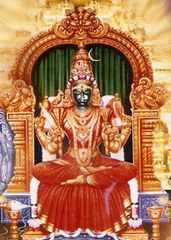 The Kamakshi Temple is a famous Hindu temple dedicated to Kamakshi, one of the forms of the goddess Parvati. It is located in the historic city of Kanchipuram, near Chennai, India and is popularly associated with Sankaracharya, one of the greatest Hindu gurus. The Meenakshi Temple in Madurai, the Akilandeswari temple in Thiruvanaikaval near Tiruchirappalli and this Kamakshi are the important centers of worship of Parvati as the mother goddess, in the state of Tamil Nadu. The temple was most probably built by the Pallava kings, whose capital was Kanchipuram, around 6 C.E.
The Kamakshi Temple is a famous Hindu temple dedicated to Kamakshi, one of the forms of the goddess Parvati. It is located in the historic city of Kanchipuram, near Chennai, India and is popularly associated with Sankaracharya, one of the greatest Hindu gurus. The Meenakshi Temple in Madurai, the Akilandeswari temple in Thiruvanaikaval near Tiruchirappalli and this Kamakshi are the important centers of worship of Parvati as the mother goddess, in the state of Tamil Nadu. The temple was most probably built by the Pallava kings, whose capital was Kanchipuram, around 6 C.E.
The main deity, Kamakshi, is seated in a majestic Padmasana, an yogic posture signifying peace and prosperity, instead of the traditional standing pose. The goddess holds a sugarcane bow and bunch of flowers in the lower two of her arms and has a pasha (lasso), an ankusha (goad) in her upper two arms. There is also a parrot perched near the flower bunch. There are no other Parvati temples in the city of Kanchipuram, apart from this temple, which is unusual in a traditional city that has hundreds of traditional temples. There are various legends that account for this fact. One of them according to Kamakshivilasa is that the Goddess had to absorb all the other shakthi forms to give a boon to Kama, the Hindu god of love. Another legend attributes it to the Raja Rajeswari pose of the deity that signifies an absolute control over the land under the deity's control. Legend has it that Kamakshi offered worship to a Shivalingam made out of sand, under a mango tree and gained Shiva's hand in marriage.
About Goddess Kamakshi
The Goddess Kamakshi is in a sitting posture in the temple. This posture is called the Padmasana posture. The Padmasana posture is said to resemble a lotus. In the Yogic practice this resembles the form of meditation. The Goddess holds a Sugarcane bow on her left upper arm and Lotus, Parrot in her right upper arm. The Goddess also has divine chakras called Pasa and Angusa in her arms.The Goddess also has a Chandraperai (a shape of moon like structure) in her forehead. The Goddess Kamakshi is situated in the middle of temple premises.
History reveals that Goddess Kamakshi was praying under a mango tree with a Shiva lingam made of sand to marry the great Lord Shiva. After a long duration of dedicated and devoted meditation to Lord Shiva, Lord Shiva appeared before her and married the Goddess Kamakshi, a divine form of Parvati. There are no traditional Parvati or Shakti shrines in the city of Kanchipuram, apart from this temple, which adds even more legend to this temple.
About Kanchi Kamakshi Temple
Kanchi Kamakshi temple is situated at about 5 acres of land and has four entrances. The main entrance of the temple has a Kalabhairavar deity on its left and the Mahishasura Mardini deity on the right. On the centre of the entrance you can see a huge Dwajasthampa. Moving further to the entrance of the Kamakshi deity you can see a Vinayaga deity. Moving on a straight line further, Goddess Kamakshi is visible. Goddess Kamakshi is surrounded by deities of Ayyapan, Saraswati, Annaporani and Adisankaracharya on its outer prakaram. The Goddess also has Varahi, Arupalakshmi Kalvarperumal (one of the 108 Divya Desam of Vaishanavities), Roopalakshmi and Arthanariswarar deities surrounding the sanctorum of Goddess on its Gayatri Mandapam. There is Santhanasthampam inside the prakaram of Goddess which is called the Nabisthan of the Goddess. There is a Srichakra Yantra (Sri Kamakoti Peetam) established by Jagadguru Sri Adisankaracharya in front of the Goddess deity. There is also a temple tank inside the premises. Kamakshi temple has a close relation with the Sri Kanchi Kamakoti Peetam and its successive Sankarcharyas. The temple has a gallery of Adisankarcharya's Life history inside the temple premises itself. Goddess Kamakshi is the main deity and the temple is one of the fifty one Shakti peetas. The temple is spelled as Nabisthana - Ottiyana peetam. The temple also has a golden Gopuram on the sanctorum of the Goddess Kamakshi deity which is visible to all devotees.
The Kanchi Kamakshi Amman Temple as a Shakti Peeth
The mythology of Daksha yaga and Sati's self-immolation is the main theme in the origin of Shakti Peethas. Shakti Peethas are divine temples of Adiparashakti. The cause of the presence of Devi's presence is due to the falling of body parts of the corpse of Sati Devi. The eyes/back of Sati Devi is believed to have fallen here. There are 51 Shakti Peeth linking to the 51 alphabets in Sanskrit. There are also arguments that the old Kanchi temple is the Shakti peetha, where Sankaracharya has installed the Shri Chakra. It is reverred world wide as Kanchi Kamakoti Peetham.